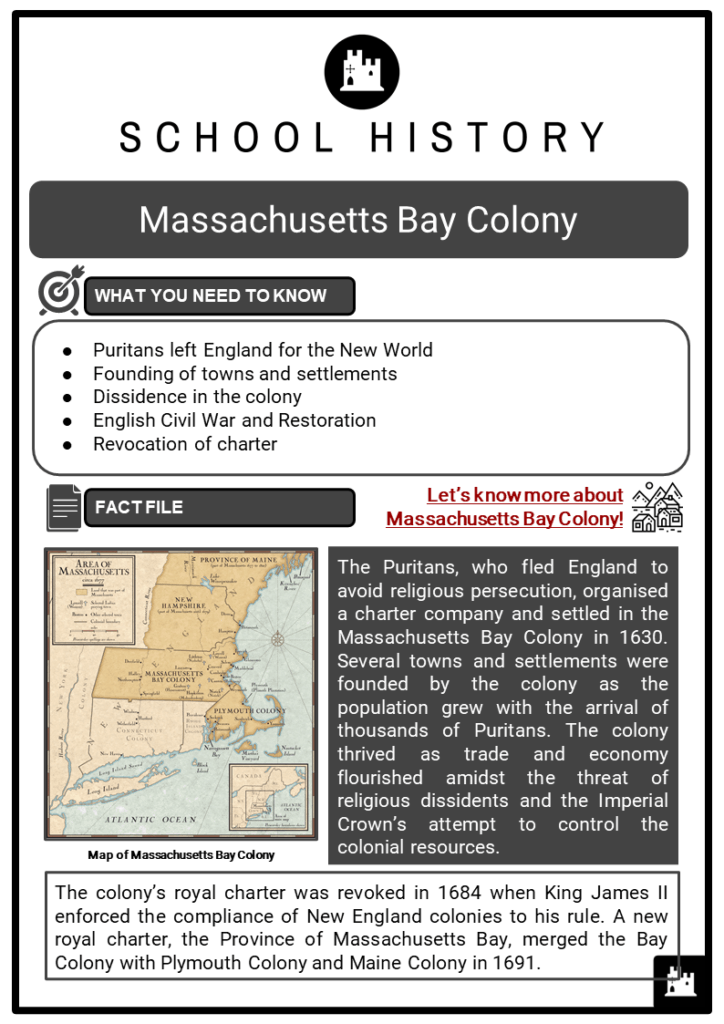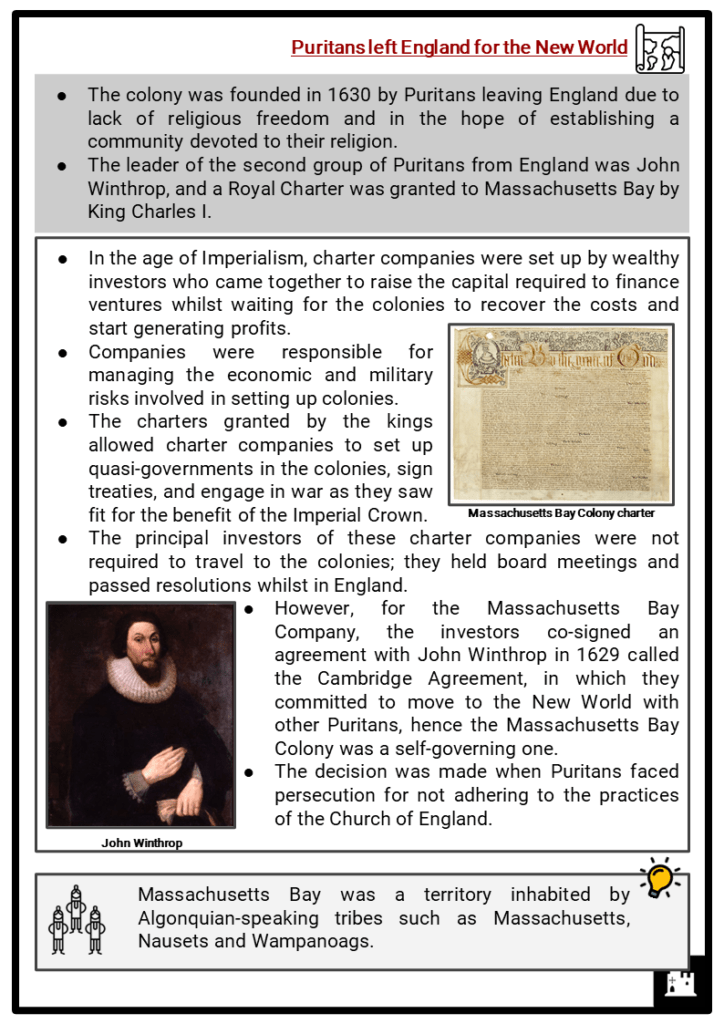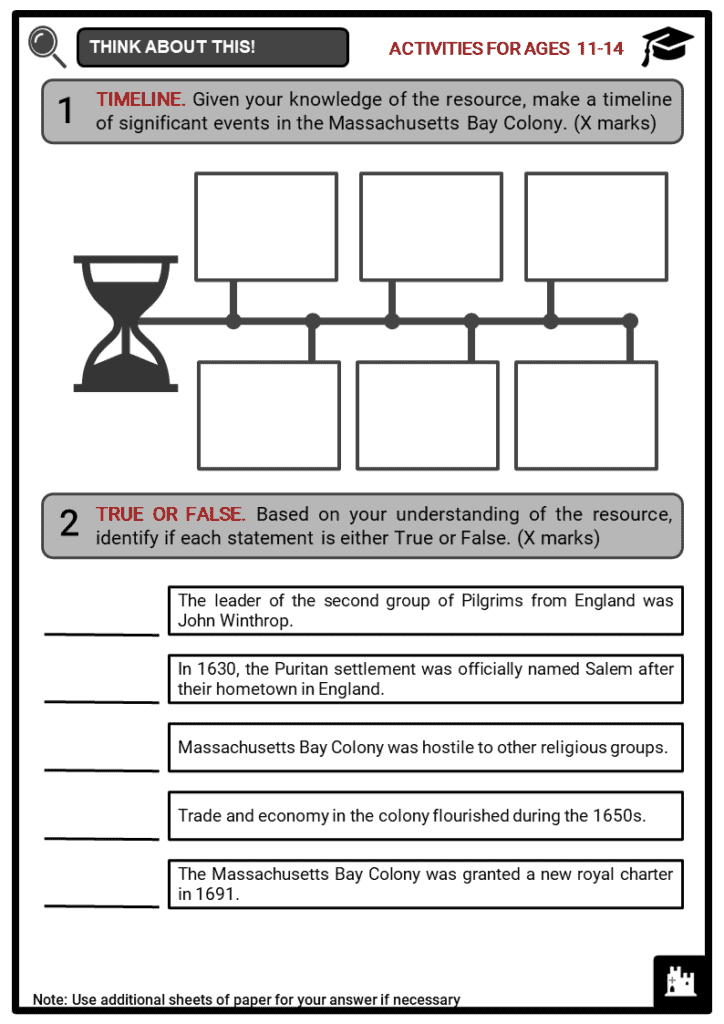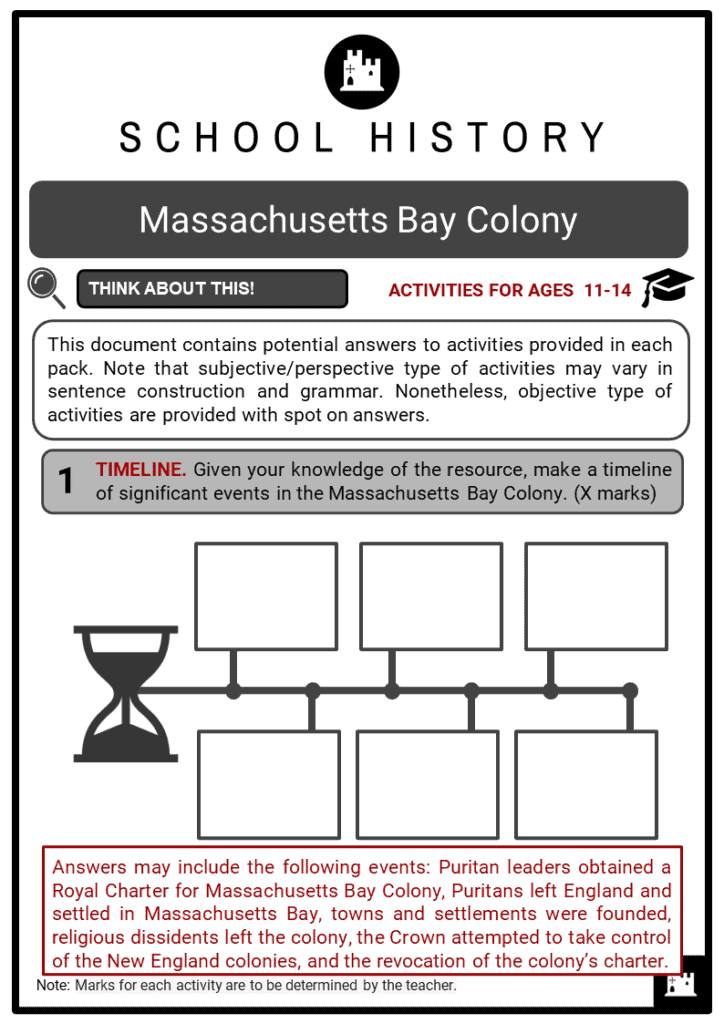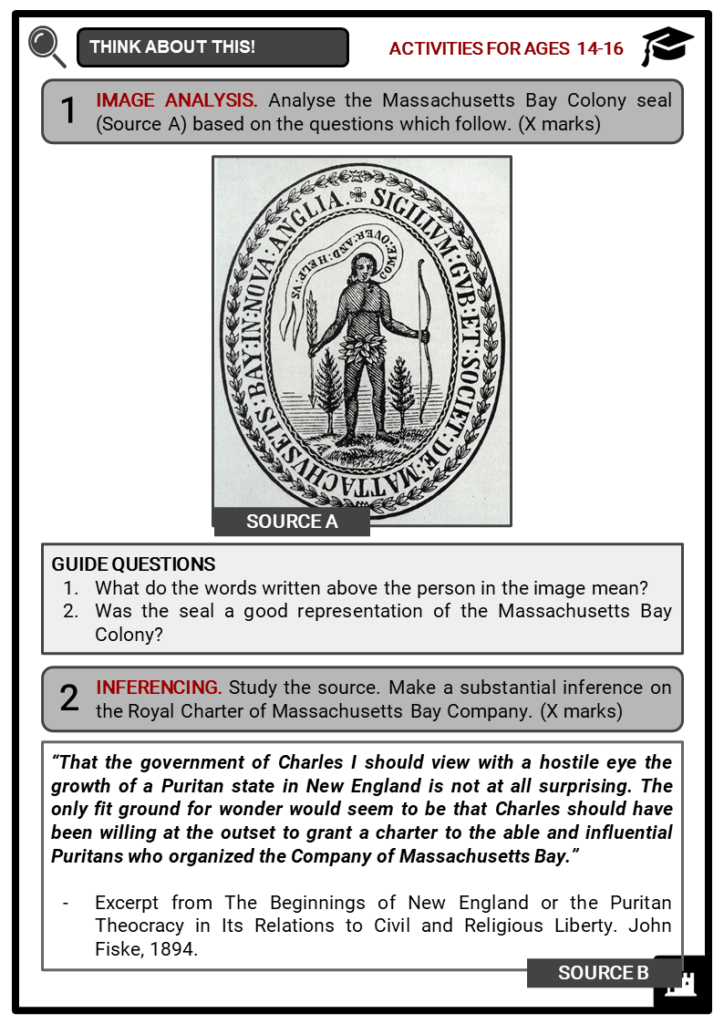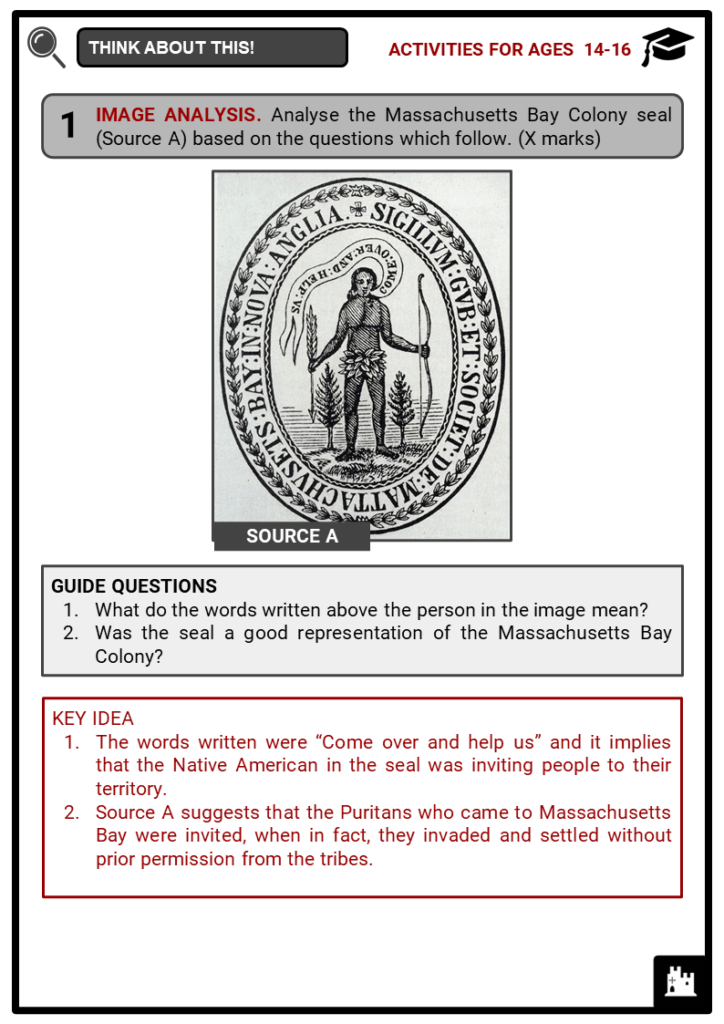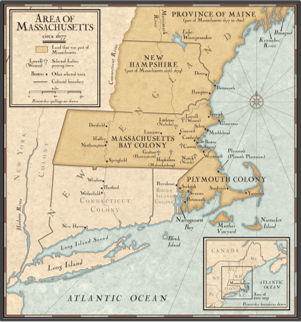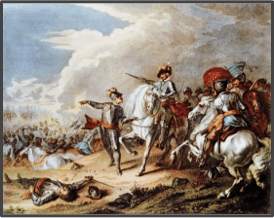Download Massachusetts Bay Colony Worksheets
Do you want to save dozens of hours in time? Get your evenings and weekends back? Be able to teach Massachusetts Bay Colony to your students?
Our worksheet bundle includes a fact file and printable worksheets and student activities. Perfect for both the classroom and homeschooling!
Table of Contents
Add a header to begin generating the table of contents
Summary
- Puritans left England for the New World
- Founding of towns and settlements
- Dissidence in the colony
- English Civil War and Restoration
- Revocation of charter
Key Facts And Information
Let’s know more about Massachusetts Bay Colony!
- The Puritans, who fled England to avoid religious persecution, organised a charter company and settled in the Massachusetts Bay Colony in 1630. Several towns and settlements were founded by the colony as the population grew with the arrival of thousands of Puritans. The colony thrived as trade and economy flourished amidst the threat of religious dissidents and the Imperial Crown’s attempt to control the colonial resources.
- The colony’s royal charter was revoked in 1684 when King James II enforced the compliance of New England colonies to his rule. A new royal charter, the Province of Massachusetts Bay, merged the Bay Colony with Plymouth Colony and Maine Colony in 1691.
Puritans left England for the New World
- The colony was founded in 1630 by Puritans leaving England due to lack of religious freedom and in the hope of establishing a community devoted to their religion.
- The leader of the second group of Puritans from England was John Winthrop, and a Royal Charter was granted to Massachusetts Bay by King Charles I.
- In the age of Imperialism, charter companies were set up by wealthy investors who came together to raise the capital required to finance ventures whilst waiting for the colonies to recover the costs and start generating profits.
- Companies were responsible for managing the economic and military risks involved in setting up colonies.
- The charters granted by the kings allowed charter companies to set up quasi-governments in the colonies, sign treaties, and engage in war as they saw fit for the benefit of the Imperial Crown.
- The principal investors of these charter companies were not required to travel to the colonies; they held board meetings and passed resolutions whilst in England.
- However, for the Massachusetts Bay Company, the investors co-signed an agreement with John Winthrop in 1629 called the Cambridge Agreement, in which they committed to move to the New World with other Puritans, hence the Massachusetts Bay Colony was a self-governing one.
- The decision was made when Puritans faced persecution for not adhering to the practices of the Church of England.
- Massachusetts Bay was a territory inhabited by Algonquian-speaking tribes such as Massachusetts, Nausets and Wampanoags.
- In 1629, a group of twelve, led by John Winthrop, left England aboard the Arbella.
- After reaching Salem, they moved onto Charlestown, eventually settling on the nearby Shawmut peninsula when Winthrop was invited by his friend William Blackstone to settle in the area.
- The Puritans began the construction of their settlement after Winthrop accepted the invitation.
Founding of towns and settlements
- The colony thrived and establishments were built for the settlers.
- In 1630, the settlement was officially named Boston after their hometown in England.
- The Puritan population grew as hundreds of colonists moved from England.
- Starvation, diseases, and the first winter tested and took hundreds of lives in the settlement.
- The steady influx of immigrants from England aided the company with fresh supplies of food and clothing.
- Boston became the capital of the Massachusetts Bay Colony in 1632.
- The surrounding towns such as Charlestown, Saugus, Newtown, Roxbury and Dorchester grew.
- Coastal communities became overcrowded which led the colonists to move inland and establish farming communities.
- As the population grew, the number of colonies in New England expanded to four, namely Massachusetts Bay, Plymouth, Connecticut and New Haven.
- Villages developed in the colonies and each village consisted of houses, a community garden and a meetinghouse for church services.
- Schools were built, and the Boston Latin School became the first public school in America.
- Laws were passed requiring the establishment of a school in every well-inhabited town.
- The four colonies formed the New England Confederation to help defend themselves against the Native Americans.
Dissidence in the colony
- Since the majority of the population of Massachusetts Bay Colony followed Puritanism, the government was theocratic with no real separation between state and church.
- Puritanism was the state-supported religion and other faiths were not tolerated.
- Laws and ordinances were issued based on the Bible teachings.
- Ministers were barred from holding public office and franchise was primarily given to church members.
- The settlement was hostile to other religious groups.
- Tensions resulted in disputes as the religious establishment in the colony was questioned.
- Some of these disputes led to the banishment of religious dissidents.
Prominent people who left the colony
Roger Williams
- He was a Puritan minister of the church in Salem, who advocated the separation of church and state and fair dealings with the Native Americans.
- He was banished from the Massachusetts Bay Colony by the magistrates in 1635.
- He settled in Rhode Island and founded the First Baptist Church of Providence.
Anne Hutchinson
- She was a Puritan spiritual advisor and an important participant in Antinomian Controversy.
- She held prayer meetings in her home for women and believed that grace came through direct revelation from God.
- She was tried for heresy and was banished from the colony by the magistrates in 1638.
- She followed Williams to Rhode Island.
Thomas Hooker
- He was a Puritan minister who led a hundred people with Samuel Stone and left the colony.
- He disagreed with the policies in the colony thus opposing the influential pastor John Cotton.
- He left the colony after his discontent with the suppression of Puritan suffrage.
- He founded the settlement of Hartford, and later, the Connecticut Colony.
English Civil War and Restoration
- When the English Civil War broke out in 1641, Oliver Cromwell and the Puritan Independents overthrew and executed King Charles I.
- Whilst there was resistance to parliamentary rule, the Parliament took control of England.
- Upon the establishment of the English Commonwealth in 1649, the colony also declared itself a Commonwealth without the permission of England.
- The Cromwell government did little to respond to this declaration since the colony was sympathetic to the parliamentary cause.
- Trade and economy flourished during the 1650s. The shipbuilding industry, fur trading, lumber and fishing industries developed and found markets in Europe and the West Indies.
- Although the colony’s government was dominated by conservative Puritans, the rise of merchant class slowly changed the political and cultural landscape of the colony.
- When Charles II became king during the English Restoration in 1660, he attempted to increase the control of the Crown over the colony.
- He established a committee to take control of the colonial resources.
- He requested the establishment of the Church of England (Protestant) in the colonies, calling for religious tolerance and permission for the celebration of Christmas and other traditions.
- The passing of Navigation Acts restricted colonial trade for the benefit of the Imperial Crown.
- All these attempts by the king were resisted by the colonies in New England.
Revocation of charter
- When the Bay Colony along with other New England colonies refused to comply with the king’s orders and requests, troops were sent to enforce the laws.
- In 1684, the royal charter of Massachusetts Bay Colony was revoked.
- Two years later, the Dominion of New England was founded under the Catholic King James II, combining all the New England colonies into one province controlled by a governor, who was appointed by the Crown.
- The Dominion of New England disregarded the leadership and administration in each colony with the appointment of one governor.
- However, when the Glorious Revolution of 1688 came about and James II was replaced by the joint reign of William III and Mary II, the colony put the Puritan leadership back in power.
- The Massachusetts Bay Colony was not granted a new royal charter, however in 1691, a new charter merged it with Plymouth Colony and Maine Colony, known as the Province of Massachusetts Bay.
- The Province of Massachusetts Bay, a crown colony, came with changes that undermined the Bay Colony’s theocratic government.
- The charter gave the Crown the right to appoint the governor, and it guaranteed the right to elect representatives to all male property owners.
- Although the new charter recognised the Crown’s authority over the colonies, the Massachusetts Bay Colony’s government grew increasingly independent.
Image sources:

